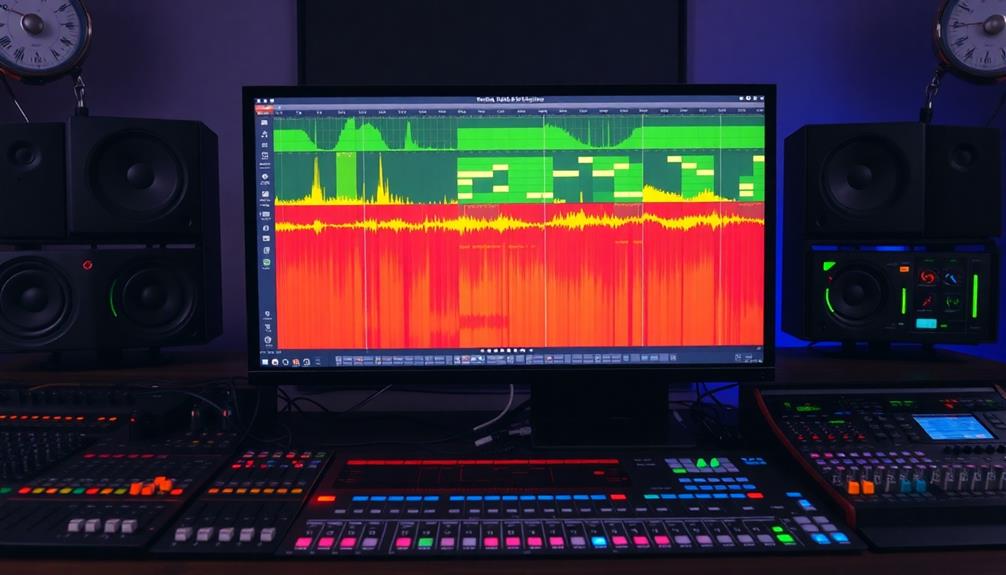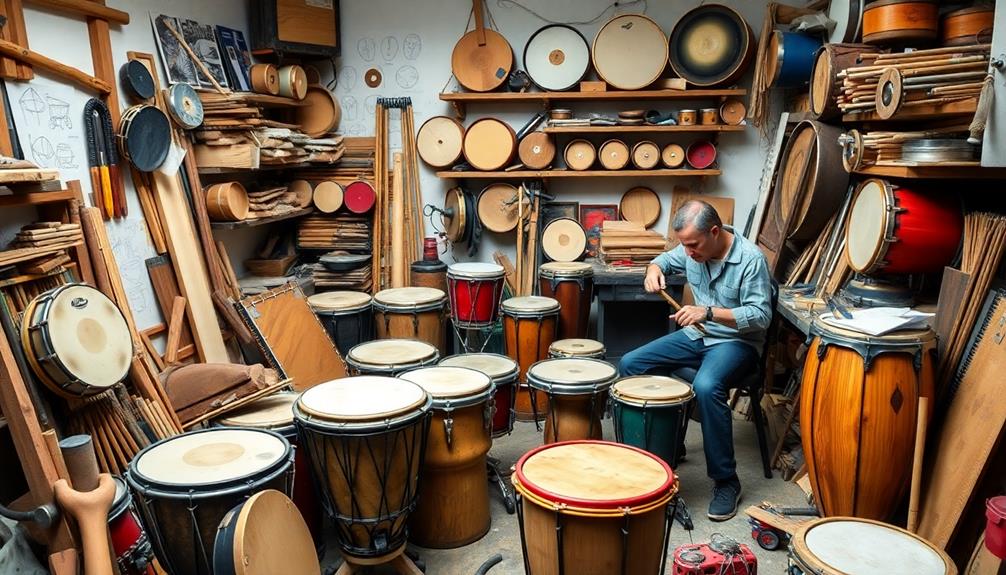To release unique textures using stock plugins, start by exploring the built-in tools in your DAW. Experiment with synths and effects like reverb, delay, and distortion to layer sounds creatively. Don't hesitate to manipulate parameters like pitch and dynamics for fresh variations. Use EQ to carve out space, preventing frequency clashes. Layer different plugins and adjust velocity for depth and complexity. Incorporate automation for engaging dynamics, and consider granular effects for innovative twists. As you apply these techniques, you'll discover ways to elevate your sound design skills and develop a signature style that captivates your audience. Additionally, resample and process your sounds to create completely new elements, allowing you to add a personal touch to your productions. By experimenting further with layering and creative processing, you can build your own sample pack, giving you a customized library of go-to sounds for future projects. This not only enhances your workflow but also ensures your tracks maintain a distinct sonic identity.
Key Takeaways
- Experiment with different stock plugins to explore unique textures that elevate your sound design beyond generic options.
- Layer complementary sounds using EQ to maintain clarity while adding richness and complexity to your mix.
- Utilize modulation techniques like LFOs and envelopes to create dynamic movements and enhance listener engagement in your tracks.
- Incorporate effects such as reverb and delay to add depth and atmosphere, transforming your sounds into immersive experiences.
- Regularly refine your sonic palette through experimentation, allowing for the creation of a signature sound that resonates with your audience.
Understanding Stock Plugins
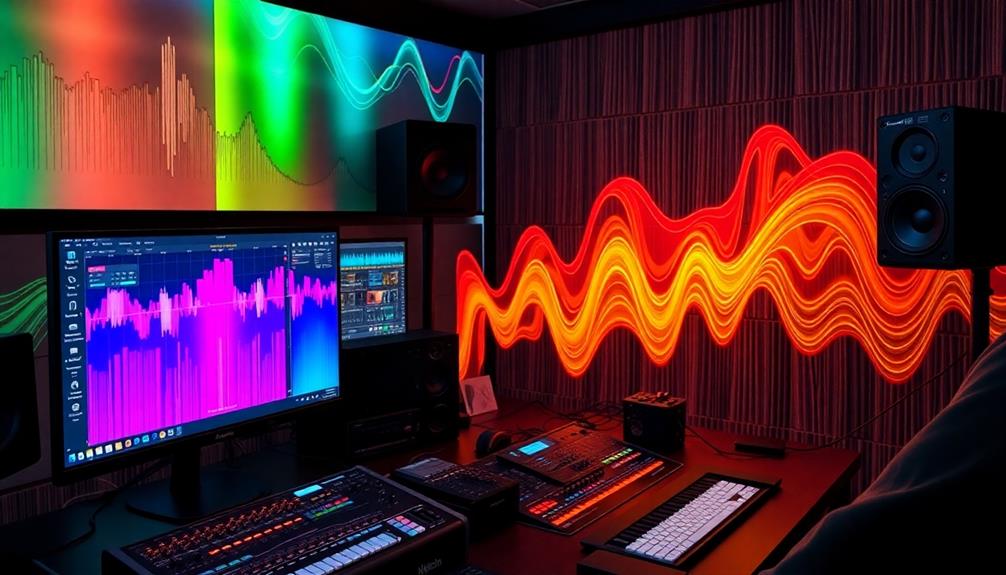
Understanding stock plugins can greatly enhance your sound design process. These built-in tools within your Digital Audio Workstation (DAW) provide essential functionalities that allow you to create unique sounds without spending extra money.
Stock plugins often include a variety of synthesizers, effects, and samplers, which guarantee seamless integration into your projects. This compatibility makes them easy to use, whether you're a beginner or an experienced sound designer.
For instance, popular stock VSTs like GMS in FL Studio are fantastic for melody creation, while Flex offers high-quality piano sounds. By utilizing these versatile tools, you can craft professional-sounding tracks efficiently.
Plus, you can modify and layer these plugins to achieve distinct textures that stand out in your productions.
The beauty of stock plugins lies in their ability to deliver impressive sound design capabilities at no additional cost. Many stock options provide audio quality comparable to paid alternatives, giving you the chance to experiment and refine your craft without breaking the bank.
Embrace these powerful tools, and you'll discover endless possibilities in your sound design journey.
Benefits of Unique Textures

Unique textures can really enhance sonic diversity in your tracks, giving them a richer and more engaging sound.
When you explore different stock plugins, you might discover inspiring elements that transform generic sounds into something truly distinctive.
This creative exploration not only sets your music apart but also invites listeners into a deeper auditory experience.
Enhance Sonic Diversity
Incorporating diverse textures into your sound design can dramatically enhance the emotional impact of your music. Unique textures evoke different feelings, capturing listeners' attention and keeping them engaged. By utilizing stock plugins, you can experiment with a wide array of sonic elements without breaking the bank. This cost-effective approach allows you to layer sounds creatively, adding depth and complexity to your compositions.
When you layer different sounds and effects from stock plugins, you not only create unique textures but also craft a signature sound that can set you apart in a crowded market. Each layer contributes to a more dynamic mix, helping individual elements stand out and ensuring your music resonates with listeners.
Exploring the capabilities of stock plugins can reveal hidden potential in your sound design toolkit. Techniques like granular synthesis and modulation can unveil innovative ways to enhance sonic diversity, pushing your creativity further.
As you experiment with these tools, you'll discover how unique textures can transform your tracks, adding emotional weight and a distinctive character that keeps your audience coming back for more. Embrace the power of stock plugins and elevate your sound design today!
Inspire Creative Exploration
Three key benefits of using unique textures in sound design can markedly enhance your creative process.
First, unique sounds can evoke specific emotions, making your compositions more memorable and engaging for listeners. For example, the radiant and heartwarming qualities found in songs like Blue Skies and Lemonade can inspire similar feelings in your own work. By accessing and manipulating various parameters within stock plugins, you're likely to uncover unexpected results that inspire new ideas.
Second, utilizing stock plugins allows you to experiment with different sonic landscapes cost-effectively. You don't need to invest in expensive third-party plugins to explore new sounds; stock options often provide rich and complex textures that can elevate your work.
Lastly, modifying and customizing stock plugin presets can lead to the discovery of unique sounds that keep your compositions from feeling generic. Layering multiple sounds can create innovative soundscapes that stand out.
Here are some benefits to keep in mind:
- Enhanced emotional impact: Evoke feelings through sound.
- Cost-effective experimentation: Explore diverse textures without breaking the bank.
- Increased originality: Customize presets to maintain a fresh sound.
Incorporating unique textures into your creative sound design will certainly inspire exploration and innovation.
Transform Generic Sounds
Transforming generic sounds into enchanting textures is essential for any sound designer looking to elevate their work. By utilizing stock plugins effectively, you can breathe new life into standard sounds and create unique textures that resonate with your audience.
It's all about layering your sound design tools and manipulating parameters like modulation and effects to achieve dynamic variations. Just like exploring the top projectors for gaming enthusiasts can enhance your viewing experience, experimenting with sound design techniques can greatly improve your audio quality.
When you experiment with techniques such as pitch shifting, time-stretching, and filtering, you'll discover innovative audio textures that set your compositions apart. These methods allow you to transform generic sounds into distinct sonic identities that stand out in a crowded musical landscape.
Instead of relying on expensive third-party plugins, stock plugins provide accessible avenues to craft signature sounds. Integrating these unique textures enhances the emotional impact of your music, creating a more immersive listening experience.
As you refine your sonic palette, remember that the key lies in experimentation and exploration. By pushing the boundaries of what you can do with stock plugins, you'll not only transform generic sounds but also elevate the overall quality of your sound design, making your work truly memorable.
Essential Sound Design Techniques
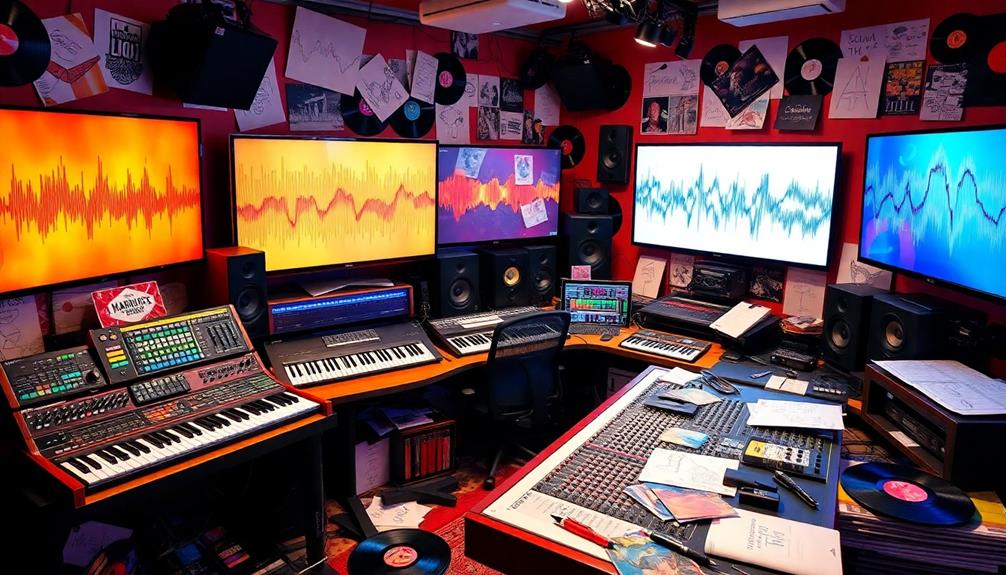
When you're crafting your sound design, layering sounds effectively can add richness and complexity to your tracks.
Modulation techniques, like LFOs and envelopes, let you create dynamic effects that keep your listeners engaged.
Layering Sounds Effectively
Layering sounds effectively is an essential technique in sound design that often enhances your compositions. By combining multiple audio sources, you create a unique sonic experience that enriches your overall sound. To achieve this, follow these key strategies:
- Choose complementary sounds with distinct frequency ranges.
- Use EQ to carve out specific frequencies for each layer. This is especially important as AI's role in sound design and other sectors continues to evolve, leading to innovative approaches in audio production, including AI-driven diagnostics.
- Experiment with effects like reverb and delay to add depth and character.
When you layer sounds, make certain each element occupies its own space in the mix. This approach prevents muddiness and maintains clarity, allowing individual textures and tonal characteristics to shine.
Utilizing EQ to carve frequencies is vital; it helps manage sonic overlap and guarantees that your layers work harmoniously together.
Additionally, incorporating effects can create a sense of depth and space in your soundscape. Regularly adjust levels and dynamics across your layers during mixing to highlight the unique qualities of each element.
Modulation for Dynamic Effects
Building on the foundation of layering sounds, modulation adds another layer of dynamism to your sound design. By dynamically changing parameters like pitch, volume, and filter cutoff over time, you create movement and interest within your tracks.
Common modulation effects, such as chorus, flanger, and phaser, introduce variations in pitch and timing, enhancing the depth and richness of your unique sound.
Using LFOs (Low-Frequency Oscillators) allows for rhythmic modulation of various parameters, enabling effects like tremolo for volume modulation and vibrato for pitch modulation. This rhythmic aspect can breathe life into static sounds, making them more engaging.
Moreover, automation in your Digital Audio Workstation (DAW) can help you create precise modulation curves, allowing for complex sound manipulation that enhances shifts and emotional impact within your composition.
For advanced techniques, consider using envelopes to shape the attack and release of sounds. This can help you craft unique audio experiences that capture listeners' attention and keep them engaged.
Exploring Distortion and Saturation
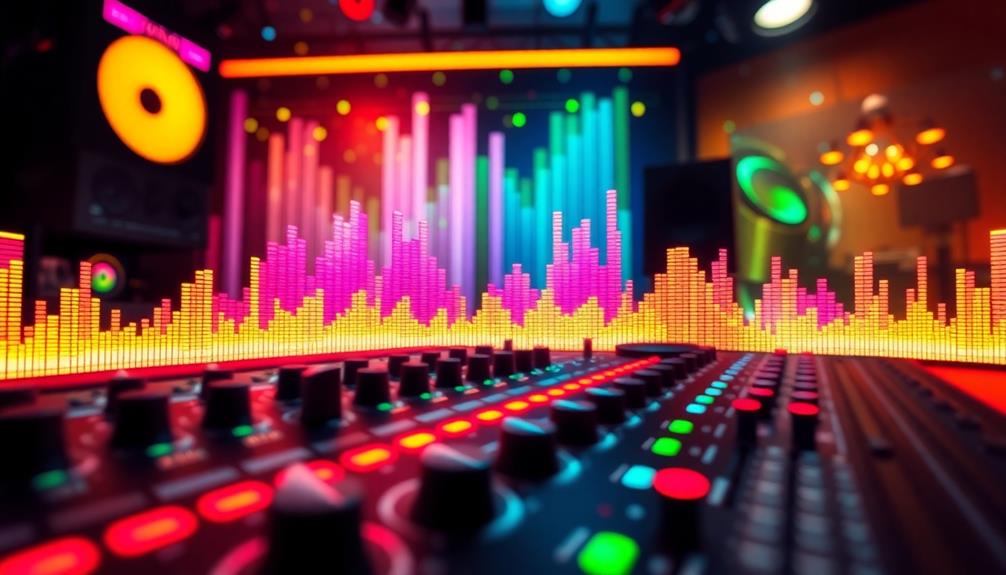
Distortion and saturation are powerful tools in sound design that can transform your audio from ordinary to extraordinary. By using the right plugins, you can introduce unique textures and character to your tracks.
Whether you're after subtle warmth or aggressive distortion, these effects can greatly enhance your mixes.
Consider these approaches for exploring distortion and saturation:
- Enhance clarity and presence: Apply saturation to individual tracks to make them stand out without relying heavily on EQ adjustments.
- Experiment with audio mangling: Use plugins like iZotope Trash 2 for creative distortion algorithms, perfect for experimental sound design.
- Emulate vintage warmth: Saturation plugins such as Waves Abbey Road Saturator can replicate the tonal qualities of classic analog gear, adding a rich, nostalgic feel to your mixes.
With versatile options like Arturia DIST Coldfire and Soundtoys Decapitator, you can tailor the distortion to fit your desired sound.
Keep in mind that these effects can be subtle or overpowering; it's all about finding the right balance for your project.
Embrace distortion and saturation to elevate your sound design game!
Utilizing Delay and Echo

After exploring the transformative effects of distortion and saturation, it's time to enhance your sound design with delay and echo. Stock delay and echo plugins in your DAW can create spaciousness and depth in your mixes, simulating natural reflections of sound in a physical space.
By utilizing features like feedback control, you can adjust the number of echoes and their decay time, enabling you to create everything from subtle ambience to pronounced rhythmic patterns.
Experimenting with delay time settings, especially syncing them with your track's tempo, enhances musicality and groove. This turns simple sounds into engaging rhythmic elements.
Don't forget to explore modulation options in your delay plugins, which can introduce pitch variations or time shifts to echoes, adding unique movement to otherwise static sounds.
Techniques like ping-pong delay, where echoes alternate between left and right channels, create a dynamic stereo image that enhances the overall listening experience.
These effects not only enrich your sound but also give you the tools to craft a more immersive mix. So immerse yourself in your plugins and start experimenting; the world of delay and echo awaits your creative touch!
Crafting With Reverb Effects

Reverb effects can transform your sound design by adding depth and atmosphere, making your tracks feel more alive and immersive. By simulating the natural reflections of sound in a space, you create a sense of distance and environment that captivates listeners.
As you immerse yourself in crafting with reverb, experiment with these key parameters to shape your sound:
- Room Size: Adjusting this affects how spacious or intimate your audio feels.
- Decay Time: This controls how long the reverb lasts, influencing the overall ambiance.
- Early Reflections: Tuning these helps separate your original sound from the reverb tail, enhancing clarity.
Different types of reverb—like hall, chamber, and plate—offer unique sonic qualities suited for various styles. For example, hall reverb delivers a lush sound perfect for orchestral arrangements.
Don't forget to incorporate modulation within your reverb effects; this can create dynamic textures that add movement and richness to your design.
Advanced Filtering and Modulation

Mastering advanced filtering and modulation can elevate your sound design, allowing you to sculpt audio with precision and creativity. By employing techniques like high-pass and low-pass filters, you can perform essential frequency adjustments that enhance clarity while removing unwanted resonances. This is fundamental for sound designers aiming for polished audio tracks.
Integrating modulation effects, such as chorus, flanger, and phaser, introduces dynamic movement to your sounds. These effects alter parameters like pitch and delay time, making your audio more intriguing and alive.
Additionally, utilizing automation within filters grants you precise control over evolving textures, ensuring they align with the emotional arc of your music.
Don't overlook multiband processing, which allows you to filter or modulate specific frequency ranges independently. This gives you greater control and depth, especially in complex arrangements.
Experimenting with feedback and resonance settings in filter plugins can yield unique sonic characteristics, ranging from subtle warmth to aggressive peaks that enrich your sound design.
Creative Granular Effects
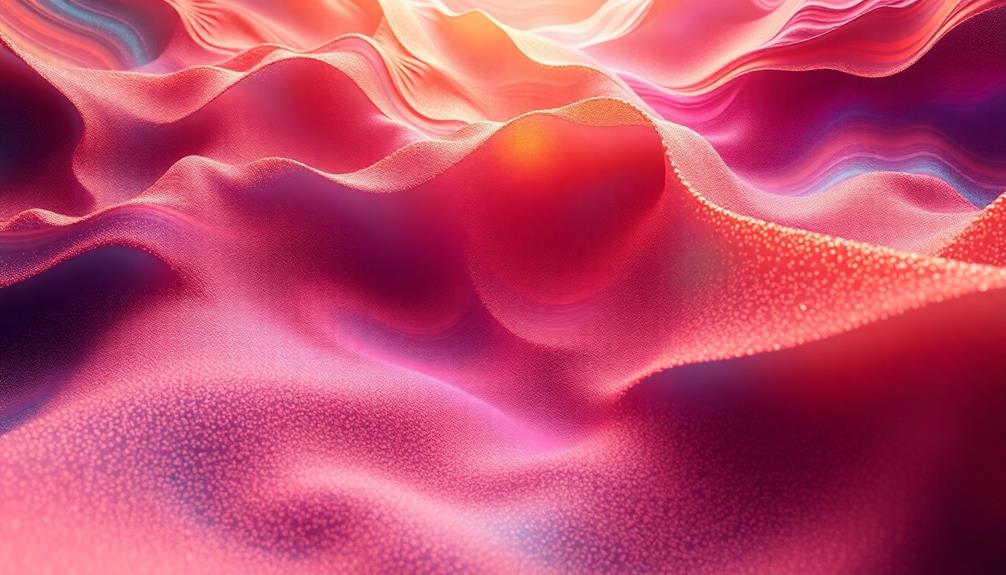
Building on the advanced filtering and modulation techniques you've explored, creative granular effects offer a fresh avenue for sound manipulation. By breaking down audio samples into small grains, you can achieve real-time manipulation of pitch, timing, and texture. This opens the door to crafting unique soundscapes that evolve and shift over time.
Consider these elements when diving into granular synthesis:
- Grain size and density: Adjusting these parameters can dramatically alter the character of your sound, leading to everything from lush, atmospheric pads to gritty, stuttering rhythms.
- Modulation options: Tools like Arturia EFX FRAGMENTS provide extensive choices, enabling you to layer grains and vary playback speed for dynamic changes.
- Combining effects: Enhance your granular textures by pairing them with traditional effects like reverb and delay, adding depth and space to your overall sonic experience.
With creative granular effects, you can create evolving textures that not only enrich your projects but also allow for experimentation in sound design. Embrace the possibilities, and let your imagination run wild!
Best Practices for Sound Layering

Effective sound layering is essential for creating rich and immersive audio experiences. Start by selecting complementary stock plugins that offer distinct sonic qualities. This guarantees each layer has its own frequency range and character, creating a professional-sounding mix. Use EQ to carve out space for each layer, reducing overlapping frequencies to let each sound shine.
Experiment with varying the dynamics and velocities of each layer. This approach will add depth and complexity, making your texture more engaging. Incorporate effects like reverb and delay on specific layers to enhance the overall atmosphere of your sound design.
To help you stay organized and streamline your intuitive workflow, consider the following best practices:
| Practice | Description | Benefits |
|---|---|---|
| Choose Complementary Plugins | Select plugins with distinct sonic qualities | Create a rich, full sound |
| Use EQ Effectively | Carve out space in the mix | Prevent frequency clashes |
| Vary Dynamics | Adjust velocities across layers | Add depth and realism |
| Save Custom Presets | Regularly organize your sounds | Quick recall and consistency |
Frequently Asked Questions
Can You Get a Professional Mix With Stock Plugins?
Yes, you can definitely achieve a professional mix with stock plugins. They're designed to work seamlessly in your DAW, allowing you to create polished soundscapes when you learn to manipulate their parameters effectively.
Can You Make Good Music With FL Studio Stock Plugins?
Imagine a painter wielding vibrant colors, crafting a masterpiece. Yes, you can create good music with FL Studio's stock plugins. With creativity and exploration, you'll discover endless possibilities that resonate with your artistic vision.
What Are the Best Logic Pro Stock Plugins Reddit?
When exploring Logic Pro stock plugins, you'll love Space Designer for reverb, Alchemy for sampling, and Channel EQ for sound shaping. Reddit users rave about Ultrabeat and Sculpture for their unique capabilities in sound design.
Conclusion
You've now got the tools to release unique textures in your sound design. By experimenting with stock plugins and applying techniques like distortion, delay, and granular effects, you can really elevate your tracks. Remember, it's not just about the tools; it's how you use them that counts. So, don't be afraid to think outside the box and let your creativity flow. With practice, you'll find yourself hitting all the right notes!

